

Why Ma’amoul Is So Special to Me
Ma’amoul cookies are, without a doubt, my favorite cookies in the entire world. They are rated number one in my book. I’ve always loved the date-filled ones, but the nut-filled versions are just as delicious.
Growing up in Jordan, these cookies were a cherished part of our celebrations. They made an appearance during Eid al-Fitr or Easter, depending on the household. But for some of us, ma’amoul wasn’t just for special occasions. It was a year-round comfort.
I have such fond memories of my mom gathering with our neighbors, Auntie Annette and Auntie Alice, to make ma’amoul together. Each day, they would meet at a different home, forming a little team that baked for one household at a time. It was more than baking. It was about community, tradition, and love.

Auntie Annette, one of my mom’s closest friends, always had a jar of ma’amoul in her fridge. She made the best ones. Truly unforgettable. Whenever I visited, she would hand me one of those cookies, and eating it felt divine. She passed away in 2006, but the memory of her ma’amoul will always stay with me.
In our community, the best bakers made ma’amoul with 100 percent semolina. If flour was added, it was seen as a shortcut. Ma’amoul made only with semolina had a special texture and taste, and those who mastered that were admired for their skill.
These cookies are not just a treat. They are a piece of my history and a reminder of the people who shaped it.
Key Ingredients You’ll Need
Complete list of ingredients and amounts can be found in the recipe card below.
- Extra Fine & Coarse Semolina: Ma’amoul is all about semolina. Extra fine (farkha) creates a tender texture, while coarse adds subtle bite. The traditional way is to use only semolina – no flour.
- Unsalted Butter or Ghee: Melted butter gives richness. Ghee or samen baladi can be used for a deeper, more traditional flavor.
- Samen Baladi (optional): A unique Jordanian fat made from sheep milk fat blended with turmeric, fenugreek, and handagoog (sweet clover). It gives a distinct flavor and aroma.
- Mahlab: This spice, made from cherry pits, adds a floral, almond-like flavor that’s essential in authentic ma’amoul.
- Mastic (optional): A natural resin that brings a piney, slightly floral note. Optional, but it gives the cookies a nostalgic taste.
- Orange Blossom & Rose Water: Used to bind the dough and provide beautiful aroma. Warm them slightly before mixing for best absorption.
- Date Paste (Ajweh): Look for soft, pit-free date paste to save time. It should be pliable and moist. You can make your own by softening and blending dates.
- Cinnamon & Anise: Used in the filling for gentle warmth and spice that balances the sweetness of the dates. If desired, you can also add a hint of ground nutmeg to the filling.
- Ghee or Butter (for the filling): Just enough fat is added to soften the date paste and make it easy to shape and fill.


Tips for Perfect Ma’amoul
- Fat: You can use melted unsalted butter, ghee, or samen baladi (spiced ghee that is very popular in Jordan). Some people also use vegetable oil. I personally like to use either butter or ghee, sometimes mixed with a little samen baladi for added flavor. A small amount of oil helps the cookies stay soft for a long time. Be sure the butter or ghee is melted and slightly cooled – too hot and it may cook the semolina.
- Liquid for the dough: To bring the dough together, I use a combination of orange blossom water, rose water, and plain water. You can use just one type of floral water or replace them with milk (or plain water) if preferred. Warm liquids help blend the dough more easily.
- Kneading and resting: Semolina dough requires gentle handling. Don’t over-knead it. After mixing, let it rest for at least 20-30 minutes so it becomes more pliable. An overnight rest before that step is essential. This gives time for the butter to fully absorb and the semolina to soften. The ideal cookie is tender and crumbly without falling apart. It should hold its shape for a few bites without crumbling in your lap or being too dense to enjoy.
- Date paste: Buy date paste that’s already prepared – it’s much easier than making your own. It’s called Ajweh or hashwet tamer in Arabic. If you prefer to make it at home, soften pitted dates with a little water, then mash or blend into a paste.
- Fats in the filling: A small amount of fat makes the date paste smooth and easy to shape. I usually use samen baladi, but melted unsalted butter, ghee, or even oil all work well. A soft filling helps prevent the dough from cracking when shaping. For nut fillings, it’s common to sweeten them with atter (simple syrup) or honey rather than sugar, which keeps the mixture moist and cohesive.
- Nut Filling Tip: For nut-based fillings, pulsing the mixture in a food processor helps the ingredients bind together and makes the filling easier and more uniform.
- Shaping: You can use a traditional ma’amoul wooden mold, which is the easiest. However, our family tradition – and that of many neighbors – was to create designs using small decorative pinchers. This method is much more time-consuming, but the effort is well worth it. Cookies shaped this way are always more appreciated because they are truly a labor of love. If using a wooden mold and having an issue with the dough sticking to the mold, try lining the mold with thin plastic wrap to make it easier to release the cookie without having to tap it repeatedly. Simply lift the plastic to remove the cookie gently.
- Traditionally, the shape of ma’amoul helps identify the filling: round cookies are usually filled with dates, oval ones are for walnuts, and round with stripes or small shapes are typically for pistachios.
- Baking: Ma’amoul bakes quickly and should remain pale golden, not deeply browned. Bake in a preheated oven at 425°F (220°C) for about 12-15 minutes. Keep a close eye so they don’t overbake or dry out.
- Cooling and storing: Let the cookies cool completely before serving or dusting with powdered sugar. Once cooled, store in an airtight container at room temperature for up to 2 weeks, or refrigerate if preferred. They also freeze well.
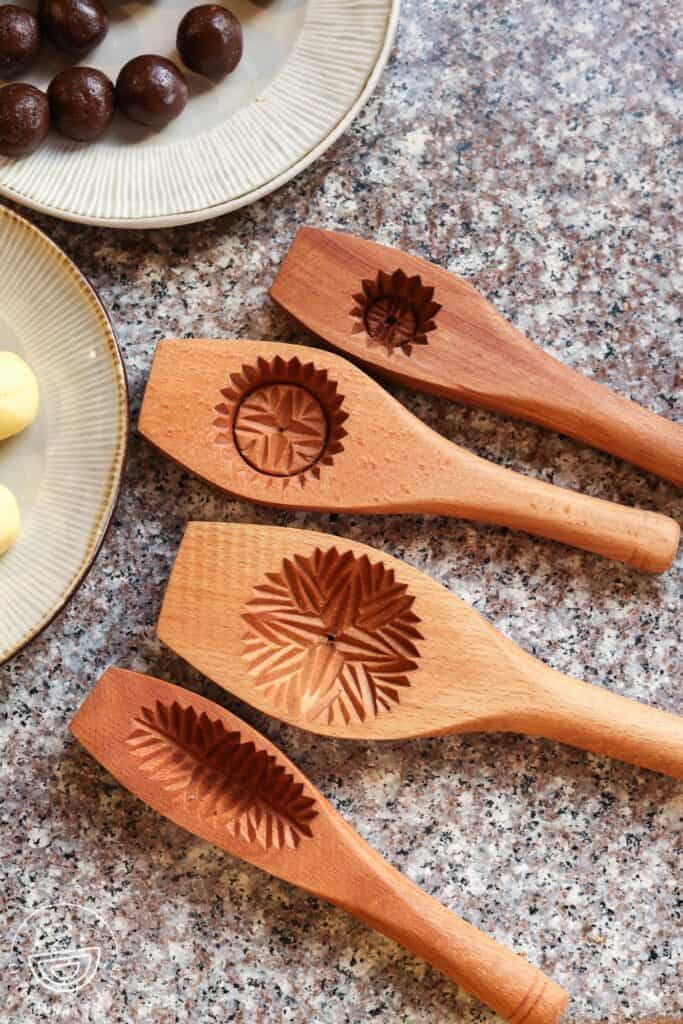
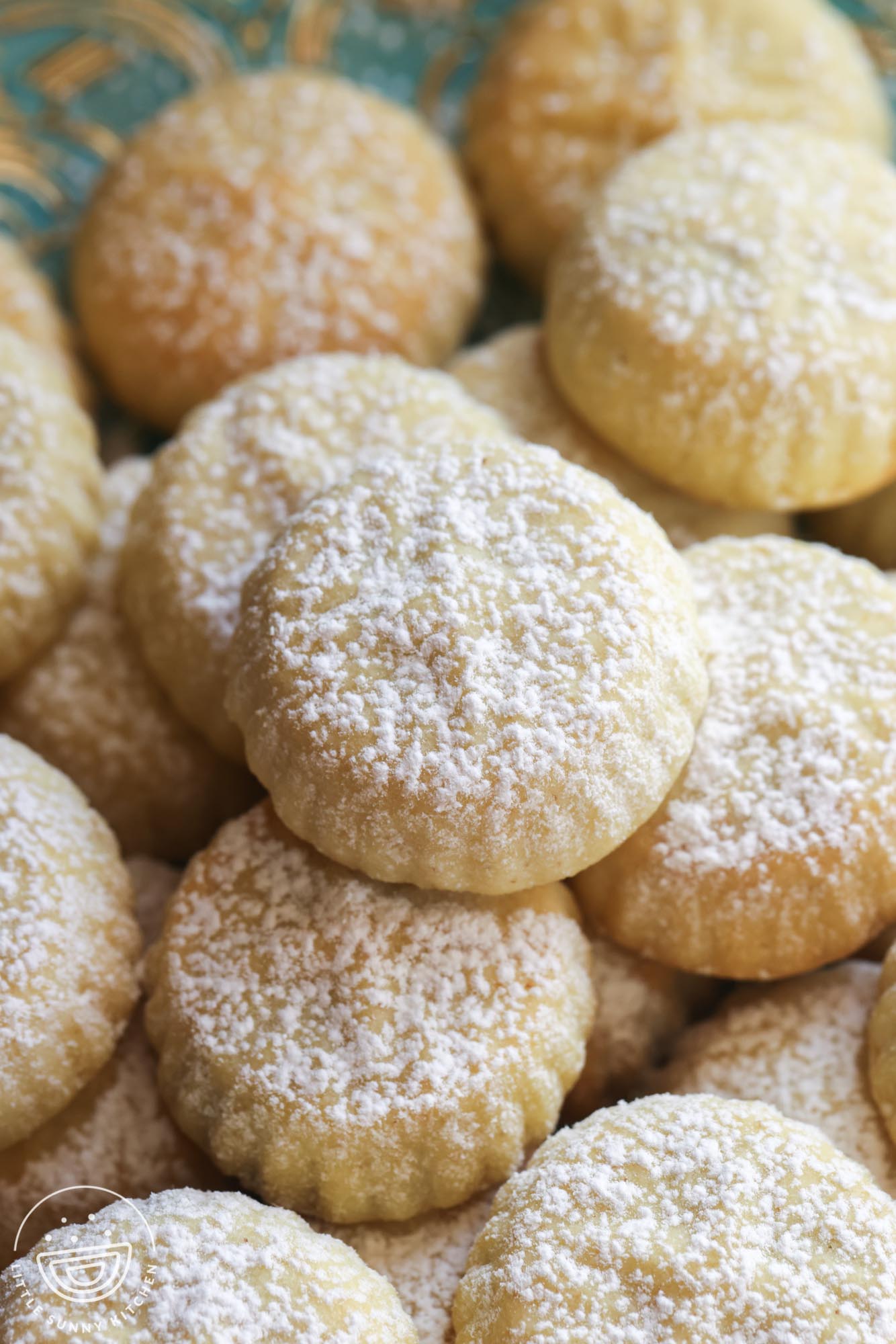
How to Store and Freeze Ma’amoul
- Room Temperature: Store ma’amoul in an airtight container at room temperature for up to 2 or 3 weeks. Line the layers with parchment paper to prevent sticking. Avoid humid environments, as moisture can affect their texture.
- Freezer: Freeze baked ma’amoul in a single layer on a tray until solid, then transfer to a freezer-safe bag or airtight container. They can be frozen for up to 6 months. Thaw at room temperature.
Tip!
Do not dust with powdered sugar before freezing. Add it after thawing and just before serving for the best look and texture.
Did you make this? Be sure to leave a review below and tag me on Facebook, Instagram, or Pinterest!

Maamoul Cookies
Recipe Video
Equipment
- Ma'amoul mold or cookie press (optional)
- Baking sheet
- Plastic wrap
Ingredients
For the dough:
- 250 g coarse semolina
- 750 g extra fine semolina
- ¼ teaspoon salt
- ¼ cup (50 g) granulated sugar
- 1 ¾ cups (400 g) unsalted butter melted, or ghee
- 1 teaspoon (4 g) mahlab seeds measured then ground
- ½ teaspoon (2 g) mastic optional, measured then ground
- ½ teaspoon instant yeast
- ¼ cup (60 ml) orange blossom water
- ¼ cup (60 ml) rose water
- ½ cup (120 ml) water
Date filling:
- 2 pounds (900 g) date paste
- 2 teaspoons ground cinnamon
- 1 ½ teaspoons ground anise
- ¼ cup (60 g) ghee or unsalted butter, melted
Walnut filling:
- ¼ cup (50 g) granulated sugar
- 2 tablespoons (30 ml) orange blossom water
- ½ teaspoon lemon juice
- 1 cup (150 g) chopped walnuts
- ½ teaspoon ground cinnamon
Pistachio filling:
- ¼ cup (50 g) granulated sugar
- 2 tablespoons (30 ml) orange blossom water
- ½ teaspoon lemon juice
- 1 cup (150 g) chopped pistachios
Instructions
- In a large mixing bowl, combine coarse semolina and extra-fine semolina, salt, granulated sugar, melted unsalted butter, mahlab, and ground mastic. Mix until all the semolina is moistened.
- Cover the bowl with plastic wrap and let the mixture rest at room temperature overnight or for up to 2 days.
- After resting, add instant yeast, warm orange blossom water, rose water, and plain water to the dough. Mix until fully combined, then cover and let it rest for 20–30 minutes.
- Meanwhile, prepare the date filling by mixing the date paste with ground cinnamon, ground anise, and melted ghee or unsalted butter until smooth and pliable.
- To make the nut fillings, start by making a simple syrup (atter). In a small saucepan, combine the granulated sugar, orange blossom water, and lemon juice. Bring to a gentle boil, stirring to dissolve the sugar, then simmer for 4-5 minutes. Remove from heat and let it cool.
- For the walnut filling, mix the chopped walnuts and ground cinnamon with the cooled atter.
- For the pistachio filling, mix the chopped pistachios with the cooled atter.
- Preheat the oven to 425°F (220°C) and line a baking sheet with parchment paper.
- Weigh out 20 gram pieces of dough.
- Weigh out 16 gram pieces of date filling.
- Flatten the dough into a round disk in your palm, shape the date into an oval (kibbeh-style), place it inside the dough, and seal it. Roll gently to smooth the surface.
- For walnut filling, use the same ratio as the date filling (20 g dough to 16 g filling). For pistachio filling, use 8 g dough to 4 g filling. Shape and seal the same way.
- Press each filled dough ball into a ma’amoul mold or shape by hand.
- Tap the mold to release the cookie or gently lift if lined with plastic wrap.
- Place shaped cookies on the prepared baking sheet, spacing them slightly apart.
- Bake the larger cookies on the center rack for 12-15 minutes or until lightly golden, and the smaller pistachio cookies for 8-10 minutes. Do not overbake.
- Let cool completely before serving. Optionally, dust with powdered sugar.
Notes:
- You can make all date-filled or all nut-filled cookies, depending on your preference.
- The size of the cookie will depend on the mold you are using, as molds can vary in shape and size. It’s best to test one cookie first and adjust the dough and filling amounts as needed.
- A good rule of thumb: make the dough weight approximately 4 grams more than the filling weight to avoid tearing or filling exposure.
- Letting the dough rest overnight allows the semolina to fully absorb the butter and soften, resulting in a melt-in-your-mouth texture.
- You can substitute the orange blossom or rose water with milk or water if preferred, but the floral flavor is traditional.
- Use medjool dates or store-bought date paste; ensure it is soft and free from pits.
Nutrition Information
This website provides approximate nutrition information for convenience and as a courtesy only. Nutrition data is gathered primarily from the USDA Food Composition Database, whenever available, or otherwise other online calculators.
© Little Sunny Kitchen
Maamoul variations
Classic Fillings:
- Date Filling: Traditional and most popular. Made with soft date paste mixed with a bit of fat (ghee, butter, or samen baladi) and spiced with cinnamon and anise.
- Walnut Filling: Mix finely chopped walnuts with cinnamon and sweeten with atter (simple syrup) or honey. Add a splash of rose water for aroma. Traditionally shaped into oval cookies.
- Pistachio Filling: Chopped pistachios sweetened with atter or honey and lightly scented with rose water. Typically shaped into round cookies with pinched or striped designs.
Not-So-Common Fillings and Variations:
- Date Filling with Nuts: A twist on the classic date version – combine date paste with chopped nuts like walnuts or pistachios for a more textured filling.
- Cashew Filling: Cashews can be used in place of walnuts or pistachios.
- Apricot or Raisin Filling: Chop dried apricots or golden raisins and cook with a splash of water until soft. Blend into a thick paste and add a pinch of ground cinnamon. Sweeten with honey if needed and scent with rose or orange blossom water.
- Halva Filling: Soft tahini-based halva can be used as a filling for a rich and unique twist.
- Flour Variation: Some recipes mix semolina with a bit of flour for a softer dough, though 100% semolina is preferred for authenticity.
- Vegan Version: Use vegetable oil instead of butter or ghee, and ensure the date paste is free of added dairy.

Common Ma’amoul Issues & Troubleshooting
Can I make the dough without resting it overnight?
While technically possible, skipping the overnight rest compromises the texture. The semolina needs time to absorb the butter fully for the best crumbly, melt-in-your-mouth consistency.
Why is my dough cracking when shaping?
If your dough is cracking, it might be too dry. Try adding a teaspoon of warm water at a time and gently knead until pliable. Also, ensure it hasn’t cooled too much – slightly warm dough is easier to work with.
Do you have to oil the cookie mold?
Not necessarily for each use. If your dough is rich enough, the fat in it usually prevents sticking. However, lightly dusting the mold with flour or lining it with plastic wrap can help with easy release. Since the mold is made of wood, you should treat it like any wooden kitchen tool – keep it dry and oil it occasionally with food-safe mineral oil to prevent cracking or drying out.
Why is my baked ma’amoul too hard?
This usually happens if the dough was overworked or lacked enough fat. Make sure to use the correct fat ratio and avoid kneading too much after adding the liquids.
Why did my ma’amoul flatten or lose its shape while baking?
Too much filling or not sealing the dough properly can cause spreading. Also, avoid over-softening the dough with excess liquid. Chill the cookies for 10-15 minutes before baking to help them hold their shape.
How much filling should I use so it doesn’t burst through the dough?
A good rule of thumb is to keep the filling slightly smaller than the dough. Aim for about 4 grams less – so if your dough ball is 20 grams, the filling should be around 16 grams. This helps ensure the dough fully encloses the filling and prevents cracks or leaks during baking.
Make sure your dough layer isn’t too thin. It should fully enclose the filling without gaps.
How do I fix ma’amoul dough that feels too greasy or oily?
If the dough feels greasy after resting, mix in a small amount of extra fine semolina (1 tablespoon at a time) until it becomes workable again.
Can I use fresh dates instead of date paste?
Yes, but they must be pitted, softened in warm water, and blended into a smooth paste. You may also need to add a bit of fat to make them pliable enough for filling.
Can I make ma’amoul in advance for gifting or holidays?
Absolutely. Ma’amoul freezes well, and they also stay fresh in an airtight container for up to 2 weeks, making them ideal for preparing ahead of time.













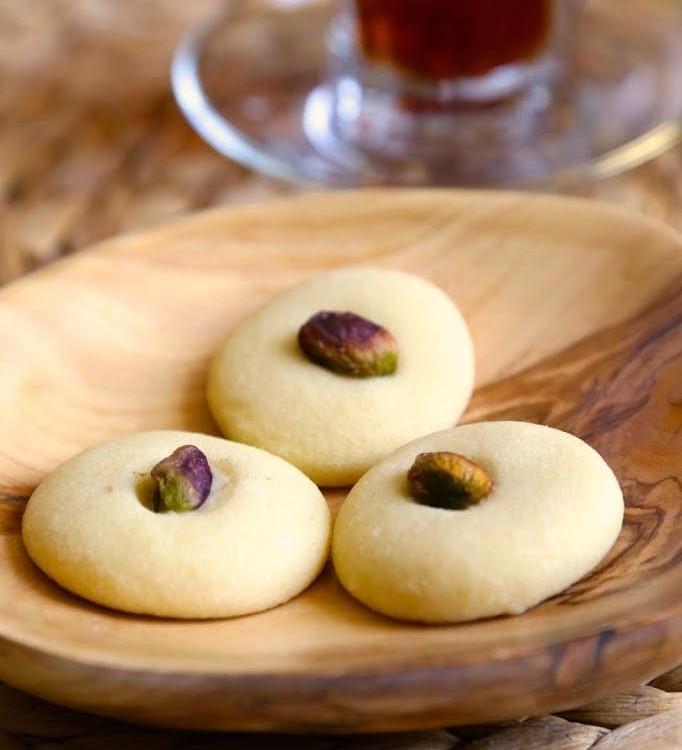
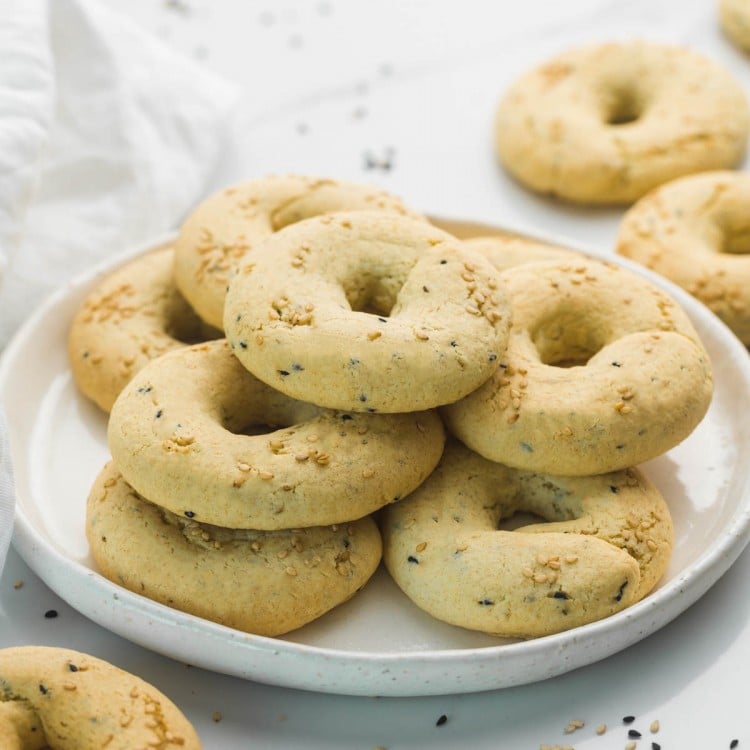


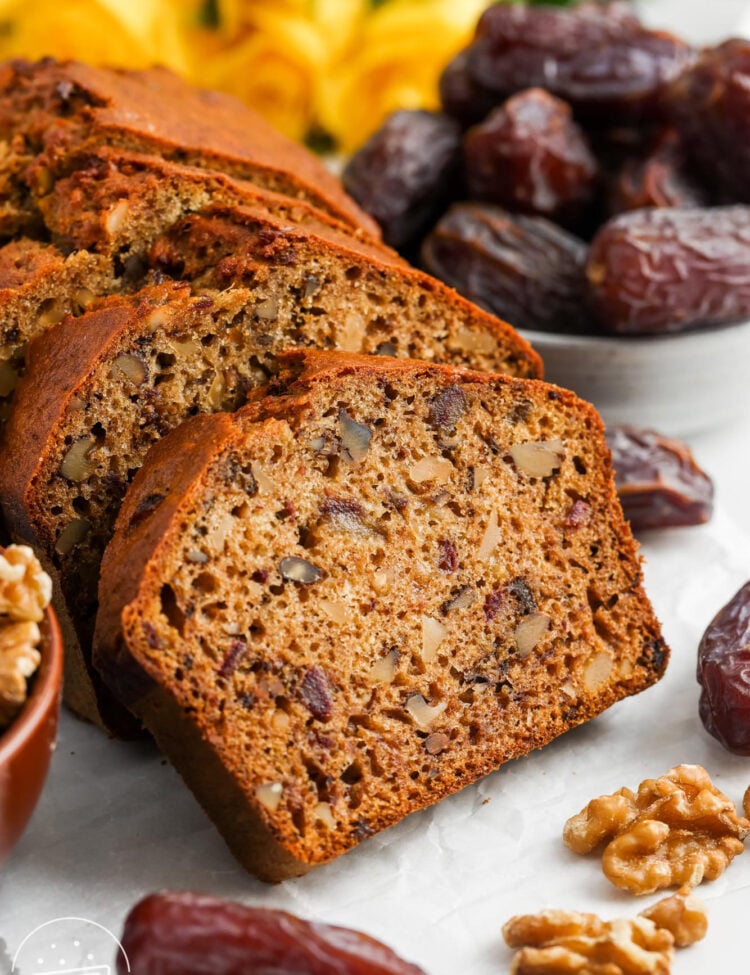
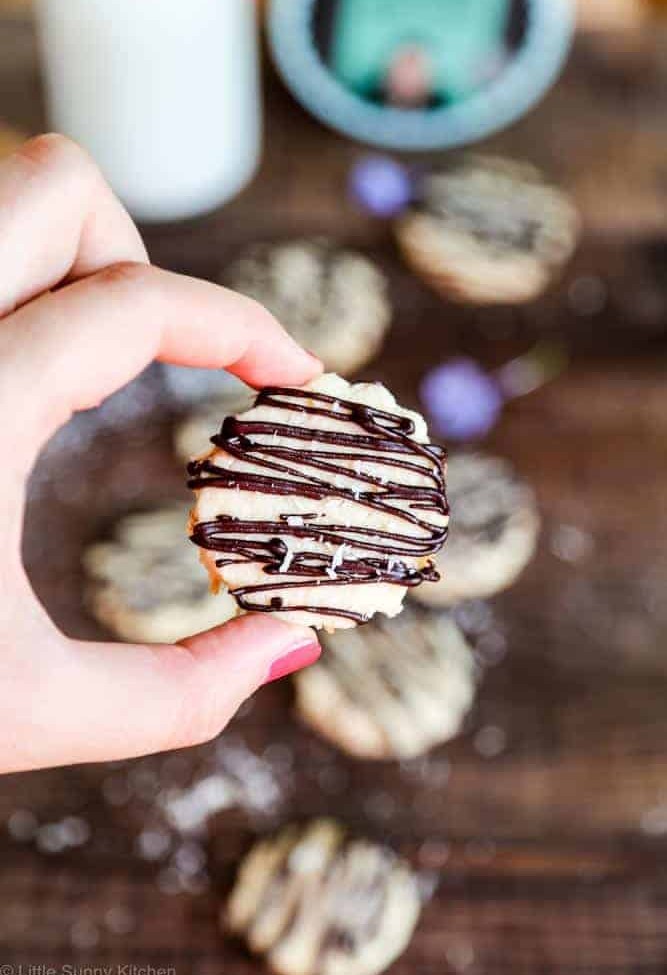
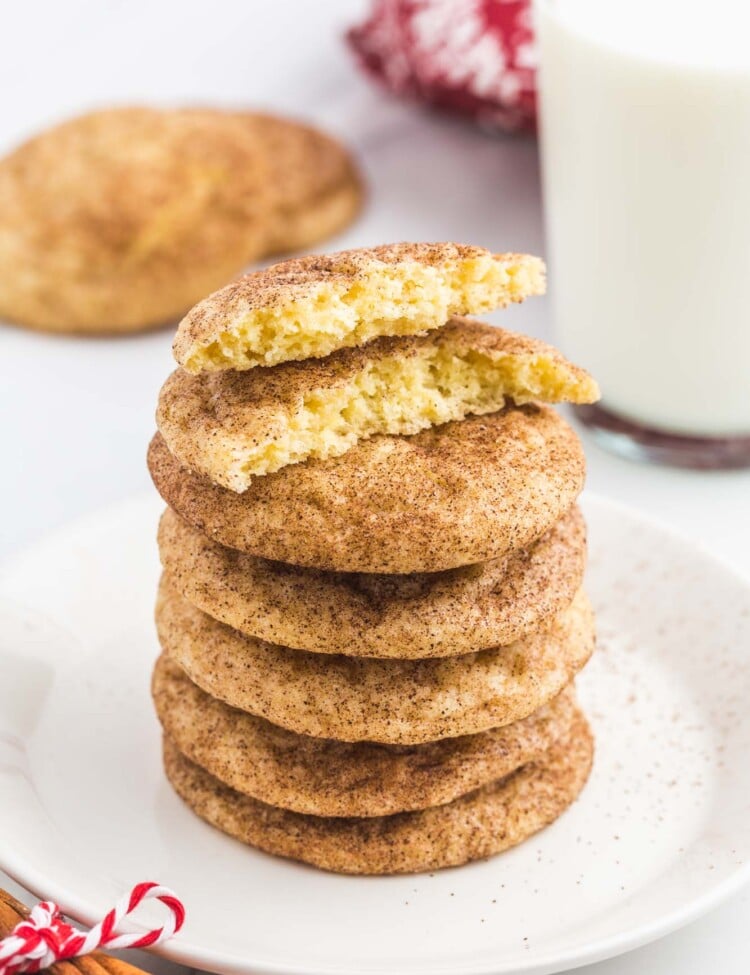
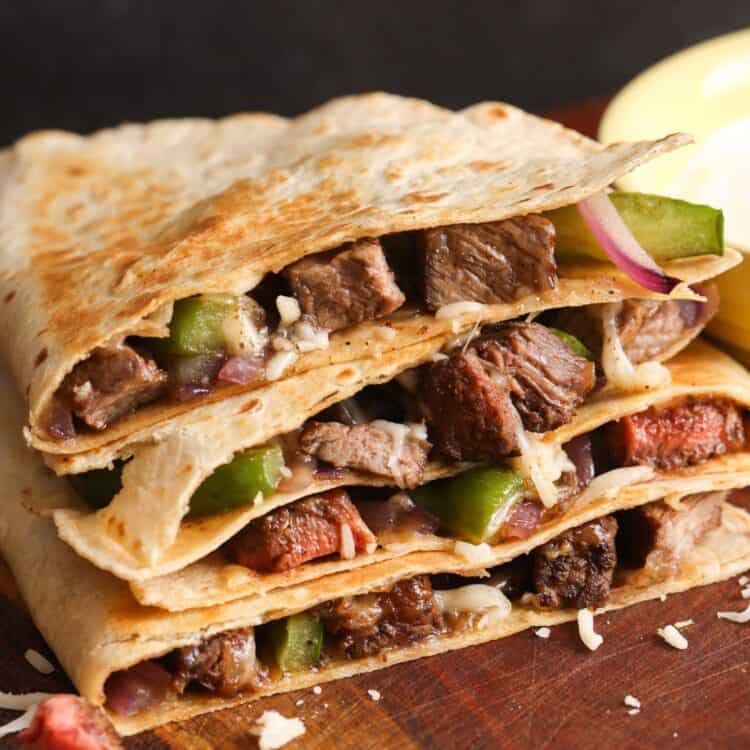
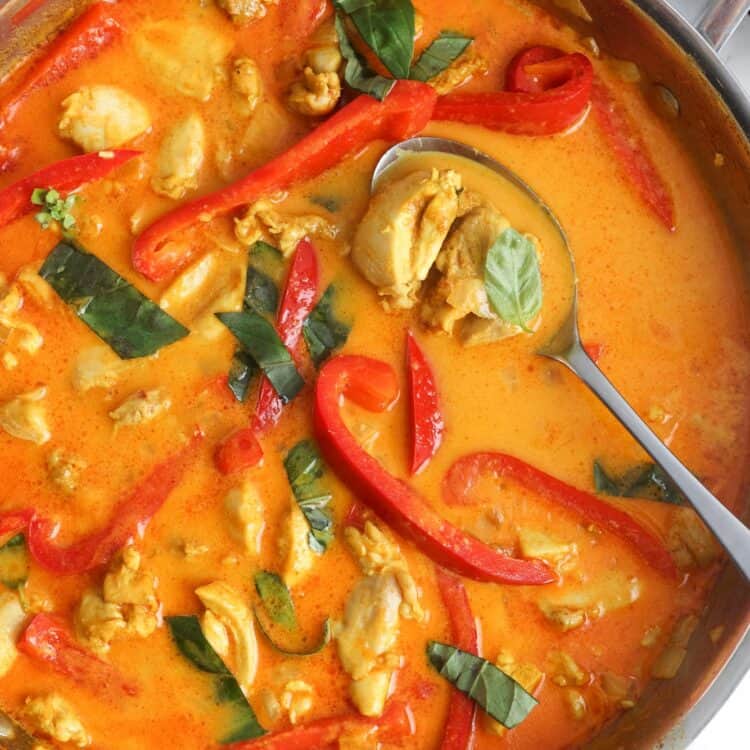
LK says
I tried 4 ma’amoul recipes and this was my favorite and keeper recipe. I have a couple of questions though – if you only have dried mahleb powder how much should you use? I’m guessing the ground seeds are much more flavorful so I’m wondering if you should use more dried. And where can we find the beautiful molds that you have pictured in the recipe? Thanks.
Diana says
I’m so happy you enjoyed the recipe! For pre-ground mahlab, I’d start with about ½ teaspoon, keeping in mind that it’s usually not as fragrant as freshly ground seeds, so you can adjust if you’d like a stronger flavor. The molds I used came from Jordan, but I’m pretty sure you can find similar ones online. Amazon or Middle Eastern shops are great places to check. Thank you for the kind review!
Ruth Laakso says
I am stoked to see this recipe. As I drove past the Damascus Cafe today, I thought of Mahmoul cookies and wondered if there was a recipe for them.
Thank you, Diana. Good timing!
Diana says
I love that! I’m so happy the recipe found you at just the right moment – what perfect timing! I hope you get a chance to try making maamoul at home. They’re such a special cookie. Let me know if you have any questions when you do! 😊
Toni says
Love this post
Years ago my first job was in this tiny Middle Eastern restaurant run by a Lebanese man. I went from being a dish washer to helping him in the kitchen. I would watch him make these cookies. I can still hear the tap/snap of the wood mold. They were my favorite.
I also learned how to make baklava and spanakopita. Those he actually LET me make. Not the cookies.
Such a warm memory.
Diana says
Hi Toni,
Thank you so much for sharing that beautiful memory! I could almost hear the tap of the wooden mold as I read your comment. It’s amazing how food can bring back such vivid moments, isn’t it? What a special experience to be part of that kitchen and learn from someone who clearly valued tradition. And how lucky that you got to make baklava and spanakopita too!
I’m so glad this post brought those memories back for you. ❤️